

Medicinal plants of the Transatlantic slave trade by RCPE Heritage on Prezi Next. Royal College of Physicians of Edinburgh. Conference Report: Traditions of Materia Medica: 300BCE–1300CE – The Recipes Project. By Sean Coughlin On 16–18 June 2021, members of the research group A03 at the DFG-funded SFB 980 ‘Episteme in Motion’ and the Institute of Classical Philology, Humboldt-Universität in Berlin (Sean Coughlin, Christine Salazar, Lisa Sherbakova, Kristiane Hasselmann, Philip van der Eijk) held a conference called Traditions of Materia Medica: 300 BCE–1300CE.
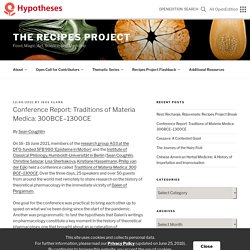
Over the three days, 25 speakers and over 50 guests from around the world met remotely to share research on the history of theoretical pharmacology in the immediate vicinity of Galen of Pergamum. One goal for the conference was practical: to bring each other up to speed on what we’ve been doing since the start of the pandemic. Another was programmatic: to test the hypothesis that Galen’s writings on pharmacology constitute a key moment in the history of theoretical pharmacology, one that brought about an acceleration of pharmacological research and reflection. The Archive of Healing, a Trove of Medicinal Folklore, Is Now Online. The digital archive features hundreds of thousands of entries describing cures, rituals, and healing methods spanning two centuries, with a focus on protecting Indigenous knowledge from for-profit exploitation.
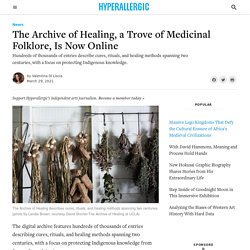
The University of California, Los Angeles (UCLA)’s Archive of Healing, one of the most comprehensive databases of medicinal folklore in the world, is now accessible online. The interactive, searchable website boasts hundreds of thousands of entries describing cures, rituals, and healing methods spanning more than 200 years and seven continents. Malarial Subjects. 'Just when we thought there was nothing more to say about medicine and colonialism, Rohan Deb Roy opens up a completely new conversation, reorienting us.
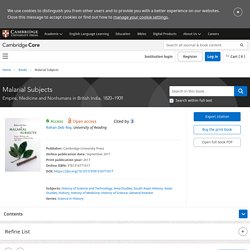
In Malarial Subjects, the postcolonial history of medicine comes face to face with posthuman science studies, and a wonderfully illuminating interchange ensues, evoking entanglements of humans, parasites, mosquitoes, cinchona plants, and quinine. Thus we learn how cinchona plants could cultivate their own impossibly modern colonial space; and mosquitoes might weave imperial nets, capturing colonisers and the colonised within them.' Warwick Anderson - University of Sydney.
Unlocking the Medieval Medicine Cabinet. Hallucinogenic drugs in pre-Columbian Mesoamerican cultures. Hallucinogens are substances that when ingested in non-toxic doses can provoke altered states of consciousness and induce unreal perceptions or distortions of the surroundings.
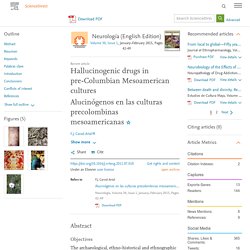
Throughout history, numerous societies have isolated substances with hallucinogenic properties from fungus, plant, and animal sources. From an ethnobotanist's and anthropologist's viewpoint, the American continents provide excellent opportunities for studying a wide array of natural hallucinogens.1. Plantas medicinais e ritualísticas dos Kaiowá do Tekoha Taquara como contribuição para a demarcação da terra ancestral, Mato Grosso do Sul, Brasil. Fungus Among Us: How One Type of Mushroom Has Been a Medical Boon Since the 1700s. – by Patrick Magee, Visitor Services/Gallery Associate Welcome to #MedievalMedicineMonday!

On Mondays, Patrick Magee, Visitor Services/Gallery Associate, will be exploring the depths of medieval botanical medicine as depicted by woodcuts found in our early printed books. The dispensatory of the Royal College of Physicians in London: [translated] with some notes relating to the manner of composition, and remarks on the changes made in most of the officinal medicines, from their first prescribers down to the present practic. Ethnobotany and the Role of Plant Natural Products in Antibiotic Drug Discovery. The crisis of antibiotic resistance necessitates creative and innovative approaches, from chemical identification and analysis to the assessment of bioactivity.
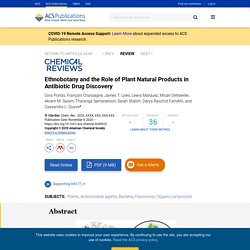
Plant natural products (NPs) represent a promising source of antibacterial lead compounds that could help fill the drug discovery pipeline in response to the growing antibiotic resistance crisis. The major strength of plant NPs lies in their rich and unique chemodiversity, their worldwide distribution and ease of access, their various antibacterial modes of action, and the proven clinical effectiveness of plant extracts from which they are isolated.
While many studies have tried to summarize NPs with antibacterial activities, a comprehensive review with rigorous selection criteria has never been performed. In this work, the literature from 2012 to 2019 was systematically reviewed to highlight plant-derived compounds with antibacterial activity by focusing on their growth inhibitory activity. Medicine Traditions - Medicine Traditions: the Ultimate Resource for Traditional Medicine. Magical, Mystical and Medicinal. A COVID-19 Vaccine Could Rely on Rare Trees in Chile. In early April, Paul Hiley was kicking back in the executive suite at Desert King International LLC, gazing out the window at the San Diego sunshine and daydreaming about his golf game.

California had issued its initial stay-at-home order for COVID-19, but apart from the hand sanitizer around the office, life was more or less normal. Retirement was on the horizon for Hiley. Maybe he’d sell the business. Maybe his son, Damian, would take over. The Wisdom of Premodern Medicine. A physician attends to a bedridden patient and observes a flask of what is likely urine.

Urinalysis was among the most common diagnostic tools of medieval medicine. Detail from Es spricht der Meÿster Almanasor, Augsburg, 1483. The Huntington Library, Art Museum, and Botanical Gardens. It was an extraordinary and somewhat serendipitous occurrence that led to The Huntington's becoming one of the best institutions in the United States to study European medicine from the latter half of the 15th century. In brief, Henry E. RHS Lindley Library – Digital collections. “for nervous afflictions” The roots of plants of the genus Paeonia (peony) family have historically been used to treat a variety of ailments.
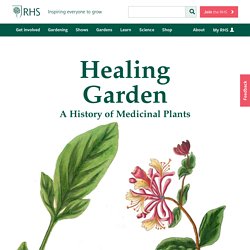
In particular, they were recommended for children with epilepsy, with the roots “either taken inwardly, or hung about their necks”. In the herbals of the early 1600s this condition was known as the ‘falling sickness’. By the publishing of Elizabeth Blackwell’s herbal in 1737, however, the modern name can be seen as she notes the peony’s use for “Epilepsy, Apoplexy and all kinds of Convulsions”.
Medicinal gardens worldwide – Google My Maps. History of medicinal plants: Map of the plants in the United States from 1932. The Vault is Slate's history blog.
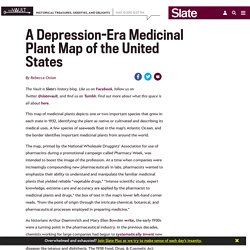
Like us on Facebook, follow us on Twitter @slatevault, and find us on Tumblr. Find out more about what this space is all about here. This map of medicinal plants depicts one or two important species that grew in each state in 1932, identifying the plant as native or cultivated and describing its medical uses. Herbal history: Five garden plants with a hidden past. Image copyright RHS Lindley Collections Many garden plants we're familiar with today have a hidden history. Grown centuries ago for their reputed healing powers, they became garden staples, valued for their beauty, form or scent. Pulmonaria, with its spotted leaves, was thought to symbolise diseased lungs, and used for chest infections.
Medicinal plants may be a key to understanding other cultures. A new methodology for comparing herbal medicine across societies can also be used to understand the transfer of cultural traditions. "I did a thorough documentation of the natural remedies, mostly plants, used by the Amazigh people in the High Atlas. Then, I studied how modernization in its various forms influences the use of plants," explains Irene Teixidor-Toneu, a postdoctoral fellow at the University of Oslo, Norway. "To summarize, there is a change in the use of substances, since people are open to medication prescribed by the doctor. At the same time, traditional knowledge and beliefs concerning plant use are kept alive, although traditions also change over time. " Having spent almost a year in the Moroccan High Atlas mountains, ethnobotanist Irene Teixidor-Toneu finished her Ph.D. on the use of medicinal plants in Amazigh (Berber) villages.
Henriette's Herbal Homepage. The Medicinal Garden. Medicinae Plantae Healing plants through time. Digital Exhibition Item Description: |1|Peter Schöffer (1425-1503) Herbarius Latinus 1484|Schöffer was an early German printer, who studied in Paris and worked as a manuscript copyist in 1451 before apprenticing with Johannes Gutenberg. This herbarius was compiled from older sources and was popular enough to go through ten reprints before 1499. It was compiled by Johann Wonnecke von Caub (Johannes de Cuba, in Latin) and many of the illustrations are by Erhard Reeuwijk, a Dutch painter and illustrator.
This was Schöffer’s most ambitious illustrated work and it features the newly designed Fraktur typeface which had just been made in Nuremberg. Medicinal Plants of Laos. Turning To Plant Science For Help Against COVID-19. 1. We're 52 years old 2. We organise events, 'Pharmaceutical Historian' journal, social media & awards 3. We're passionate about sharing #PharmHist - our journal is #OpenAccess & our lectures are free! @KewMobileMuseum @HistPharm @FacultyHP @IPOP_ Points: The Blog of the Alcohol & Drugs History Society. Editor’s Note: Over the next few weeks, we’re going to feature a series of articles discussing drug use in Africa.
These articles originally appeared on The Conversation, but we’re republishing them here as well. Today’s article comes from William Beinart, professor at the University of Oxford. It was a drug produced in Nottingham in the United Kingdom that led us on a journey to South Africa to visit muthi markets, archives, herbariums and nature reserves. We spoke with traders, healers, scholars and conservationists to learn more about Dioscorea sylvatica. Dioscorea is a wild yam. Materia Medica: An unusual obsession with glass bottles? – FBMH News.
Have you ever looked at a scientific specimen… no, I mean really looked? Looked in so much depth that you actually start looking at the container, not the specimen itself? Well, that’s what is being done currently with the Materia Medica Collection at Manchester Museum. Centre for the History of Science, Technology and Medicine (CHSTM) PhD candidate Jemma Houghton and her archaeology colleague (now alumna) Dr Linnea Kuglitsch, have been looking into the glass jars and bottles which encase the historical medicinal specimens, in a citizen science project to uncover the history of the collection. Herbal Medicine. Museum of Pharmacy Jagiellonian University Collegium Medicum - Magiczny Kraków.